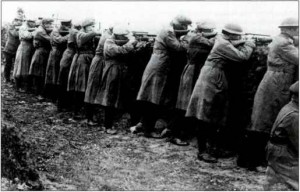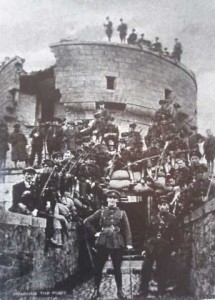Report on Irish Civil War Conference, Drogheda, September 2012

Cathal Brennan reports from the John Boyle O’Reilly Autumn School conference on the Irish Civil War
On the 16th of September John Dorney and I attended the 18th annual John Boyle O’Reilly Autumn School in the D Hotel in Drogheda. The title of this year’s school was The Irish Civil War and its Legacy – 90 years on, a re–appraisal.
The National Army and the Civil War
The first talk of the day was by Dr. Philip McConway entitled, ‘O brothers’ blood! O iron time! What horrors have we left undone?’ Lethal violence and retribution exacted by Provisional Government forces in the Civil War. At the outset of the Civil War one of the major fears of the new Provisional Government and the general staff of its army was that their soldiers would mutiny or fall into indiscipline if asked to engage their old comrades on the Anti – Treaty side.
The Anti – Treatyites certainly believed this to be a viable possibility and targeted them with propaganda and pamphlets. A National Army report in September of 1922 appeared to confirm this by stating that, ‘enemy propaganda is the biggest danger among our troops’. Despite this, mass defections did not take place.
McConway, who has specialised in the Civil War in the midlands, looked at the scale of intensity with which the war was prosecuted by the Pro – Treatyites in different parts of the country. In some areas, Free State soldiers were reluctant to carry out executions and some IRA prisoners were allowed escape while in other parts of the country, notably Dublin and Kerry, atrocities against prisoners were widespread.
The Free State, A Palace of Jobbery?
This was followed by Dr. Gavin Foster’s talk, A ‘Free State Palace of Jobbery’? Political preference in employment and economic victimisation in the Civil War and its aftermath. One of the most regular criticisms of the new Free State government was that their supporters were looked after with public sector jobs while many Anti – Treatyites were blacklisted or were forced to emigrate to find employment.
The press and Pro – Treaty supporters were indignant over the fact that someone like Rory O’Connor, an engineer with Dublin Corporation, was still being paid half wages while in prison. A Pro – Treaty postmaster in Galway temporarily stopped pension payments to families suspected of aiding Republicans during the Civil War but the potential backlash against such a policy meant the new government abandoned the idea.
The fact that Anti – Treaty activists and supporters were interned well into 1924 meant that their families also took a major hit economically. Foster’s talk showed that blacklisting was not as widespread as some Republicans claimed with some Anti – Treatyites managing to get public sector employment despite their politics and others held on to the jobs while avoiding signing the new loyalty pledge to the Free State. The resentment though was widespread as even private sector companies who employed Republicans were subject to harassment and raids on their businesses. Republicans who emigrated in this period carried a deep seated antipathy to the new state as they felt they were exiled from their own country.
The anger towards the new government did not just come from Anti – Treatyites. With the conclusion of the Civil War the Free State government had an army of over 60,000 men. This was far too large and expensive a force for peace time and rapid demobilisation of the military was required. The government made efforts to ensure that former soldiers had preference in public sector employment but the feeling among soldiers who had also served with the pre – truce IRA was that ex – British soldiers in the National Army were not being demobilised while Old IRA men were being let go. This was one of the major issues leading to the ‘Army Mutiny’ of 1924. Some former Free State soldiers also turned to bank robberies and organised crime.
Was the Civil War a Class War?
Dr. Conor Kostick asked, Was the Civil War a Class War? The issue of class is one that is largely ignored in works dealing with the Civil War but is an area that Kostick has covered in books and lectures on the period. Kostick stated that the Civil War should not be regarded as a class war as both sides drew support from different classes in Irish society. Despite this, the press, the major landowners and industrialists did line up solidly behind the new Free State regime.
Class conflict in rural Ireland tended to follow an east / west divide with rural labourers in the east striking for better pay and condition while the rural poor in the west concentrated on cattle driving and seizing land belonging to landlords and the bigger farmers.
The Farmers Freedom Force was founded in 1922 to put down what they saw as ‘anarchy, socialism and bolshevism’ in rural Ireland with the aid of the new government and the military to crush strikes by agricultural labourers and to combat land seizures. The Special Infantry Corps of the National Army was used to put down this wave of rural radicalism.
The rise of working class militancy was not something that had begun with the outbreak of the Civil War but was growing throughout the War of Independence. Soviets or workers councils had sprung up throughout the country, particularly in Munster and south Leinster, and the red flag was raised over creameries, railway stations and factories. A strike by postal workers during the Civil War was ruthlessly suppressed by the Free State Army.
The end of war time price restrictions by the British government saw an explosion in the prices of bacon and butter. This was a boon for Irish farmers but dock workers impounded the goods and refused to allow them to be exported which greatly embarrassed the new government and aroused the anger of the large farmers.
While the Labour movement was quietly pro – Treaty, many activists saw the potential defeat of the Treaty as a victory for socialism. Following his release from prison in the United States, James Larkin returned to Dublin just as the Civil War was concluding. Addressing a crowd outside Westland Row (Pearse) Railway station he stated that, ‘we are against the Treaty but there are other ways to fight.’ This summed up the feeling of many within the Labour (and Republican) movements.
The Civil War and Irish Life: how deep was the split?

Professor Eunan O’Halpin gave a very interesting and personal talk about The Civil War and Irish Life: how deep was the split? O’Halpin talked about the hierarchy of victims where we tend to remember the big houses burned out by Republicans but not the cottages of the poor burned out by the British or Free States. In many cases friendly relations remained between the families who were bitter enemies. O’Halpin praised the work of local and community historians and called on the government to release all the archives relating to this period in time for the 1916 centenary.
The shelling of Millmount Fort and the Civil War in Drogheda
Seán Corcoran, the chair of the Old Drogheda Society delivered a talk on The shelling of Millmount Fort and the Civil War in Drogheda. On the 16th March 1922, the Royal Irish Constabulary evacuated Millmount Fort and it was then occupied by the local Anti – Treaty IRA. In May a Black and Tan based in Gormanston was shot dead leading to reprisals in Drogheda. This prompted the mayor of Drogheda, Phil Monaghan, to contact the Provisional Government and ask them to send a National Army garrison to the town. On the 4th of July 1922 Free State troops under Ned Stapleton begin shelling Millmount Fort using 18 pounder gun that the previous week were being used against the Four Courts in Dublin. The Fort took heavy damage and after several hours of bombardment the Anti – Treaty garrison surrendered. This was followed by a panel discussion and a question and answer session with the public.
Overall the Autumn School was highly enjoyable and well run with some very interesting talks throughout the day. The talks were videotaped and we will include the links in the comment section when they are posted online.
The conference was organised by the Old Drogheda Society. The society was founded in 1964 and in 1974 they opened a museum (Link http://www.millmount.net/) in the Millmount Fort. For more on the Civil War, see our archive here.